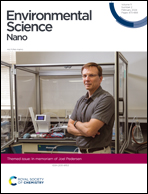Influence of aluminum incorporation and aqueous conditions on metal ion release of high-Ni transition metal oxide nanomaterials†
Abstract
Developing a materials perspective of how to control the degradation and negative impact of complex metal oxides requires an integrated understanding of how these nanomaterials transform in the environment and interact with biological systems. Doping with aluminum is known to stabilize oxide materials, but has not been assessed cohesively from synthesis to environmental fate and biological impact. In the present study, the influence of aluminum doping on metal ion release from transition metal oxides was investigated by comparing aqueous transformations of lithium nickel cobalt aluminum oxide (LiNi0.82Co0.15Al0.03O2; NCA) and lithium nickel cobalt oxide (LiNi0.80Co0.20O2; NC) nanoparticles and by calculating the energetics of metal release using a density functional theory (DFT) and thermodynamics method. Two model environmental organisms were used to assess biological impact, and metal ion release was compared for NCA and NC nanoparticles incubated in their respective growth media: moderately hard reconstituted water (MHRW) for the freshwater invertebrate Daphnia magna (D. magna) and minimal growth medium for the Gram-negative bacterium Shewanella oneidensis MR-1 (S. oneidensis). The amount of metal ions released was reduced for NCA compared to NC in MHRW, which correlated to changes in the modeled energetics of release upon Al substitution in the lattice. In minimal medium, metal ion release was approximately an order of magnitude higher compared to MHRW and was similar to the stoichiometry of the bulk nanoparticles for both NCA and NC. Interpretation of the release profiles and modeling indicated that the increase in total metal ion release and the reduced influence of Al doping arises from lactate complexation of metal ions in solution. The relative biological impacts of NC and NCA exposure for both S. oneidensis and D. magna were consistent with the metal release trends observed for minimal medium and MHRW, respectively. Together, these results demonstrate how a combined experimental and computational approach provides valuable insight into the aqueous transformations and biological impacts of complex metal oxide nanoparticles.



 Please wait while we load your content...
Please wait while we load your content...